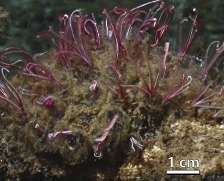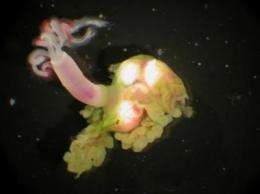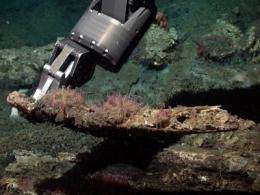July 2, 2012 report
Researchers discover how 'zombie worms' bore into skeletons

(Phys.org) -- In 2002, researchers from the Monterey Bay Aquarium Research Institute discovered a unique species of worms in the ocean that live off of the skeletons of dead fish and whales on the sea floor, by boring into them; giving rise to the nick-name, zombie worms. What was perplexing though, was how they managed this trick since they lacked mouths, teeth or even a gut. Closer analysis over the years found that the worms lacked any other means for drilling as well, causing most to believe they made their way into bone material using some sort of chemical process, rather than drilling. Now new research by Sigrid Katz and colleagues from the Scripps Institution of Oceanography proves that to be the case. She and her team are to give a presentation regarding their findings at this year’s Society for Experimental Biology conference.
The worms, of the Osedax (bone devourer in Latin) family, further added to their mystery when subsequent research failed to turn up any males of the species. More recently, other researchers found that this was because the males never grow out of their larval stage and simply live inside the bodies of the females indefinitely. Other researchers had also found that the worms had assistance from bacteria living inside of them to digest the bone material once it made its way inside. But how it got there was still a bit of a mystery.

To find out what was going on Katz and her team analyzed the green root-like part of the worm that attached itself to the outside of the bone. There they found that the structure was made of long cells, each with tiny protrusions that allowed the worm to cover a lot of bone territory. They also found that the cells had acid secreting enzymes that moved through the skin which was able to break down the minerals in the bone material, and that was how they managed to worm their way inside.

With the mystery solved, the team hopes that more research by others in the field will focus on the somewhat mysterious life cycle of the so called zombie worms. Also of interest no doubt, will be the exact makeup of the acid the worms secrete and how it is dealt with by the internal bacteria that do the work of turning the bone material into food.
More information: Conference abstract A7.17
Drilling for nutrition: The physiological mechanism of bone penetration by Osedax
Annelids belonging to Siboglinidae lack a gut and obtain nutrition via bacterial symbionts housed in a specialized organ called the trophosome.
While most siboglinids host chemoautotrophic symbionts, which allow them to thrive in reducing habitats such as hydrothermal vents or methane
seeps, Osedax exploits vertebrate bones lying on the seafloor. In contrast to other siboglinids, Osedax house heterotrophic Oceanospirillales
bacteria in their posterior body, which are modified into so-called ‘roots’. These roots penetrate and ramify through the bone, which serves as their food source (Goffredi et al., 2007). Osedax lack any obviously bioabrasive structures and the physiological mechanism of bone erosion and nutrient absorption was virtually unknown. The ultrastructure of the root epidermis suggests secretory/ absorptive functions of this region and we hypothesized that Osedax demineralize the bone by secreting acid, followed by absorption of bone collagen and lipids for nutrition. Our analysis of putative acid-secreting proteins, namely vacuolar H+ -ATPase (VHA) and carbonic anhydrase (CA), by immunohistochemistry and quantitative immunoblotting, shows preferential location and high abundance of VHA in the root epidermal cells. CA also co-occurs with VHA in the root epidermis, and is found in other cells and body regions, suggesting that CA is also involved in maintaining the acid–base balance throughout the worm. These results support our hypothesis on bone erosion via acid secretion by Osedax, which is similar to chemical mechanisms employed for boring by some gastropods and for bone demineralization by human osteoclasts.
Poster Session – Sunday 1st July 2012
© 2012 Phys.Org


















